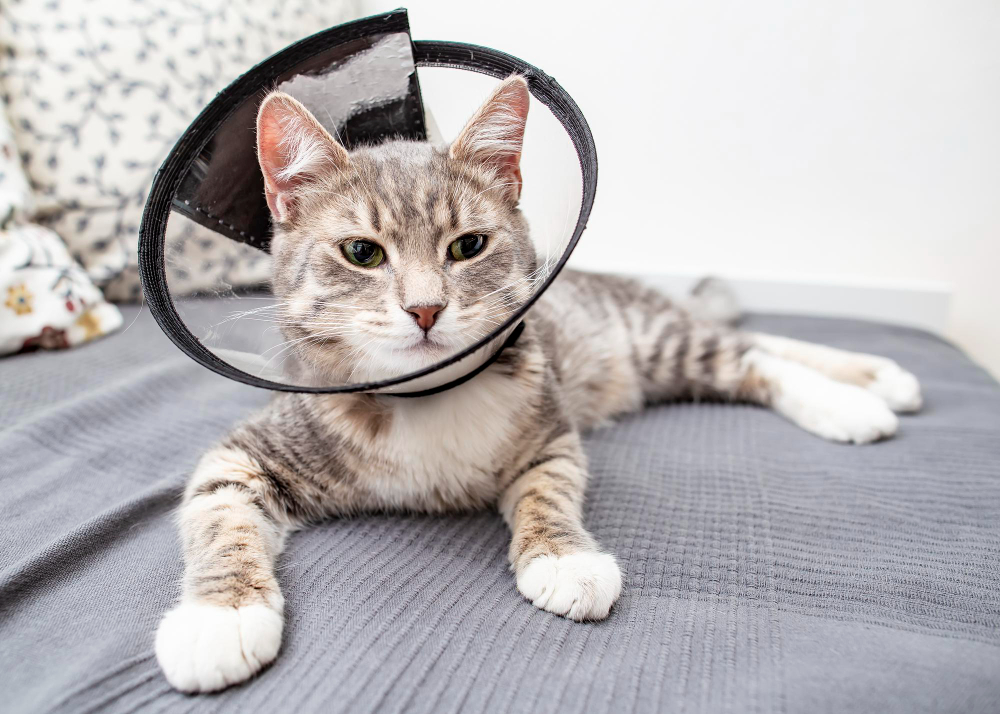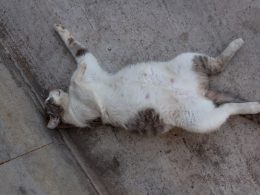A plastic or cloth hood or cone is an Elizabethan collar (also known as an E-collar or the cone of shame) that helps shield injuries or wounds from further injury. These collars keep the cat from licking or gnawing at a wound on its body and scratching or pawing at its face or head. The primary goal of the collar is to keep your cat from injuring a surgical site or an injured section of the body.
Although many cats dislike wearing a safety collar at first and may try to remove it fiercely, most cats will rapidly grow accustomed to it. Nevertheless, it’s crucial to keep an eye on your cat for the first few hours she’s wearing the collar to make sure she doesn’t get a paw trapped in it or injure herself.
Wear the collar until the wound has completely healed. It might take as little as a few days or as long as a few weeks, depending on the extent of the injury. It’s critical to follow your veterinarian’s directions to reduce the time you must wear the collar.
A well-fitted cone will fit snugly around the animal’s neck, allowing one or two fingers to pass between the collar and the neck but not allowing the animal to remove it. Any sharp edges should not be pressed on the neck. Depending on the part of the body you’re protecting, the cone should reach a bit over the tip of the animal’s snout. Wounds at the tips of the tail or the foot, for example, may require a longer cone since the animal can access these areas more easily with their jaws. With head wounds or lesions, the cone is intended to protect the face, eyes, and or ears from being clawed or pawed at, as well as from being rubbed against surfaces such as the floor, sofa, walls, and so on, and may be significantly shorter.
Safeguarding Your Neutered Cat’s Wound: The Anti-Lick Elizabethan Collar
Your pet will be fitted with an Elizabethan collar, except for male cat neuters. It is worn around the head and resembles a vast lamp shade. Its objective is to keep your pet from chewing or licking the wound. For the next ten days, the collar must be constantly worn.
The stitches will unravel, and the wound will become infected if you do not wear the Elizabethan collar and your pet licks the wound. Therefore, a significant problem must be avoided by wearing an Elizabethan collar on your pet. In addition, because the Elizabethan collar will not prevent other animals from licking the wound, you should keep your other pets separate until the healing process is complete. It is also suggested that you refrain from engaging in physical play that might injure the wound.
The Healing Process for Your Neutered Cat: When to Remove the E-Collar
It might not be very comforting to consider after-care for your neutered cat, especially if it is your first time. You might not be entirely aware of the required after-care or expected conduct following the surgery. In addition, allowing your cat to lick their wound can result in discomfort, infection, and an increased chance of the incision site opening.
Avoid allowing your pet to lick the operation site since this might result in a severe infection. The E-collar on your pet should keep him from licking. After surgery, keep the E-collar on for seven to ten days. Contact the postoperative care line if your pet is still licking the operation site while wearing the E-collar.
Your cat is more likely to become infected if he licks himself following the treatment. It’s also feasible that he’ll injure his incision. If your cat is licking himself, you should get him an e-collar (the cone) if the vet does not supply one. This will keep him from licking the area. It’s best if your cat wears the cone for at least 5-7 days.
The cone should be remained on for 10-14 days if your cat suffered an abdominal incision. This is because abdominal incisions are required when one or both testicles are within the body. If you’re unsure if you should remove the cone yet, wait until your cat’s next checkup. The vet will use the follow-up appointment to establish where they are in the healing process, enabling them to remove the cone and resume everyday grooming routines.
If your cat has a conventional neutering treatment, the cone can be removed after 5-7 days, and he can resume grooming as usual. However, the cone should be remained on for 10-14 days or until the follow-up appointment if your cat underwent abdominal incisions to remove retained testicles. The follow-up session is the safest to establish when the cone may be removed, and your cat can continue their usual washing routine.
Wearing an e-collar is the best approach to keep your cat from licking the incision area. An e-collar will keep your cat from licking the wound, reducing the risk of infection. In addition, E-collars reduce the chance of the incision being ripped open.
Although your cat may not appreciate this choice at first, it will become second nature to them, and it is the most excellent way to keep your cat safe. When the collar is on, ensure sure your cat can eat, drink, and use the litter box without difficulty. You can remove the collar for feedings if required, but keep an eye on him to make sure he doesn’t try to lick his incision.
If you observe your cat become intrigued about the area or when it finishes eating, be careful to replace the collar. You may also use a neck collar to keep your cat from rubbing on the incision. A human neck brace is comparable to a neck collar. However, it will make it difficult for the cat to reach the wound.
However, if your cat is bendy, lengthy, or simply determined, this may not be enough to keep him from licking the wound. In addition, this will not help protect the incision if your cat can slip it off or access it. Therefore, when using a neck brace on your cat, keep a constant eye on him.
Warning Signs: Identifying Infections After Your Cat’s Neutering Surgery
As previously mentioned, cones must be kept on until the wound is healed. In some situations, this may require several weeks of recovery.
For kittens and cats at least eight weeks old, neutering (castration) is a frequent treatment. The testicles are removed during the neutering surgery, which can be done in several different ways. This sterilizes your cat medically, preventing them from having kittens.
Your cat’s testicles will mature as they grow older and eventually descend to the scrotum, a bag of skin meant to retain and protect them. Between 3 and 6 weeks, the testicles begin to move down into the scrotum. Due to the size and development of the reproductive organs, kittens sterilized between the ages of 8 weeks and six months will have fewer surgical difficulties.
Your cat’s neutering treatment will determine whether their testicles have dropped into their scrotum.
If your cat exhibits any of these after surgery, regardless of the technique utilized, call your veterinarian straight away:
- Swelling, redness, drainage, or an opening in the incision are all possible symptoms.
- Issues with relieving themselves
- Sudden behavioral changes in your cat, such as sluggishness
- Refusing to consume food
- Diarrhea and vomiting
During the first 24 hours following surgery, your cat was not able to urinate.
If you see any of the following indications of infection in your cat’s operation site: swelling, bleeding, discharge, or redness, call your veterinarian immediately.
Even if your cat is acting normally, follow your veterinarian’s instructions for all medications, including pain relievers. Any food adjustments required following surgery will be discussed with your veterinarian.
Caring for Your Pet After Surgery: The Importance of Sleep and Cone Use
Some surgical treatments include washing the open region, cutting out damaged tissue, and re-stitching the entire incision, depending on the severity of the damage. As a result, clients often wind up paying more money on anesthesia, surgery, antibiotics, and even another operation to correct an extreme condition, not to mention the suffering the pet experiences – and a more extended recovery period.
The easiest method to get your pet acquainted with the E collar is always to have it on.
If you feel sorry for your pet and remove the cone before leaving, your pet may interpret this as a punishment and attempt to destroy it. Patients can eat, drink, urinate, defecate, and sleep with a cone. The more rigid you are with the cone, the faster they will become accustomed to it. Furthermore, pets do not bear grudges, so they will not be angry with you for sticking to the rules.
Cat Comfort: Alternatives to the Plastic Cone After Surgery
If your cat despises wearing the plastic cone, talk to your veterinarian about whether they still require it based on their postoperative behavior. Some cats are unconcerned by their sutures, while others pick at them. If your cat becomes too anxious while wearing a typical plastic cone, speak with your veterinarian about switching to a soft fabric cone or an inflated donut-style collar. Some cat owners hide the sutures with a recovery suit or a baby onesie.














